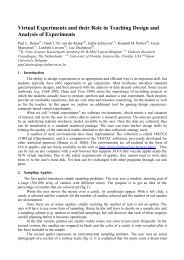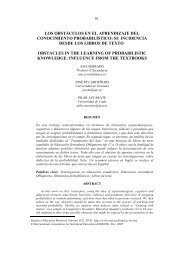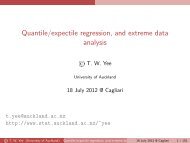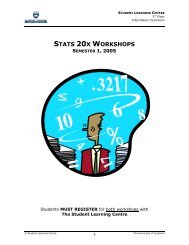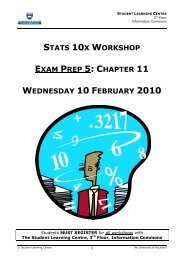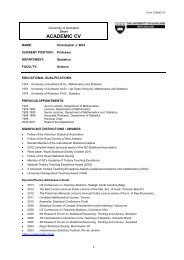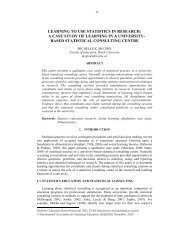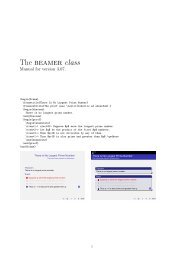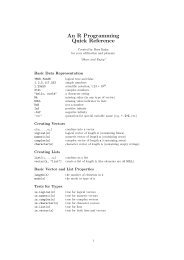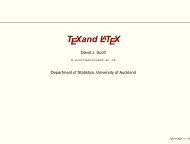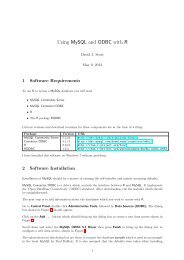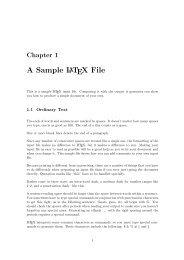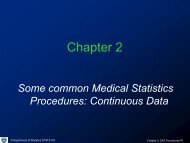modeling the growth of students' covariational reasoning during an ...
modeling the growth of students' covariational reasoning during an ...
modeling the growth of students' covariational reasoning during an ...
Create successful ePaper yourself
Turn your PDF publications into a flip-book with our unique Google optimized e-Paper software.
24<br />
Ano<strong>the</strong>r suggested line <strong>of</strong> research is how foundational topics in <strong>an</strong> introductory<br />
statistics course influence students’ development <strong>of</strong> <strong>reasoning</strong> about o<strong>the</strong>r topics.<br />
Although this study examined how ch<strong>an</strong>ges in students’ <strong>reasoning</strong> about univariate<br />
distribution influenced <strong>the</strong>ir <strong>reasoning</strong> about qu<strong>an</strong>titative bivariate data, a different study<br />
might consider how students’ <strong>reasoning</strong> about variation might influence <strong>reasoning</strong> about<br />
qu<strong>an</strong>titative bivariate data or o<strong>the</strong>r statistical <strong>reasoning</strong>.<br />
This study has employed a methodology that allows researchers to examine students’<br />
development <strong>of</strong> <strong>reasoning</strong> in <strong>an</strong> introductory statistics course in <strong>the</strong> context <strong>of</strong> a college<br />
classroom setting. It has also made <strong>an</strong> attempt at using r<strong>an</strong>domization in classroom<br />
research. Future researchers may w<strong>an</strong>t to study predictors that may account for <strong>the</strong> level-<br />
2 variation.<br />
Future research might also use a non-linear model <strong>an</strong>d time-varying predictors to<br />
depict <strong>an</strong>d explain student development. Non-linear models have been used to model<br />
ch<strong>an</strong>ge in student development (e.g., McArdle & Epstein, 1987). This might be more<br />
aligned with learning <strong>the</strong>ories that model <strong>growth</strong>, retention <strong>an</strong>d forgetting (e.g., Min, Vos,<br />
Kommers, & v<strong>an</strong> Dijkum, 2000; Murre & Chessa, 2006; Wozniak, 1990). For inst<strong>an</strong>ce,<br />
<strong>the</strong> use <strong>of</strong> <strong>the</strong> logistic curve to model population <strong>growth</strong> (introduced by Verhulst in 1845)<br />
was adapted by Pearl (1925) to model cognitive <strong>growth</strong>. Ano<strong>the</strong>r example <strong>of</strong> non-linear<br />
<strong>growth</strong> to describe learning is <strong>the</strong> hyperbolic curve outlined by Thurston (1919). Timevarying<br />
predictors c<strong>an</strong> be included in level-1 models to allow for direct effects between<br />
<strong>the</strong> predictor <strong>an</strong>d outcome <strong>of</strong> interest over time.<br />
In summary, <strong>the</strong> study <strong>of</strong> ch<strong>an</strong>ge in students’ <strong>reasoning</strong> requires multiple<br />
measurements over time. The current methodologies used to study ch<strong>an</strong>ge (structural<br />
equation <strong>modeling</strong> [SEM] <strong>an</strong>d multi-level <strong>modeling</strong>) require <strong>the</strong> same assessment to be<br />
used at each time point. This is generally not pedagogically acceptable to most college<br />
teachers given <strong>the</strong> time constraints that accomp<strong>an</strong>y collegiate courses. Even more<br />
complicated is <strong>the</strong> fact that to model a complex <strong>growth</strong> pattern requires more<br />
measurement occasions, especially <strong>during</strong> times that students are exhibiting <strong>the</strong> most<br />
ch<strong>an</strong>ge, such as near <strong>the</strong> beginning <strong>of</strong> <strong>the</strong> semester (Willett, 1989a; Willett, Singer, &<br />
Martin, 1998). This frequent testing could have a negative impact on student attitudes <strong>an</strong>d<br />
cause early fatigue in study subjects. As <strong>the</strong> call for <strong>growth</strong> studies by policy makers <strong>an</strong>d<br />
o<strong>the</strong>r interested parties increases, careful attention should be given to <strong>the</strong> methodologies<br />
<strong>an</strong>d <strong>the</strong> practical problems faced by educators in <strong>the</strong>ir implementation.<br />
ACKNOWLEDGEMENTS<br />
The authors would like to th<strong>an</strong>k Jeffrey Long, Michael Harwell, <strong>an</strong>d Jeffrey Harring<br />
for <strong>the</strong>ir methodological advice.<br />
REFERENCES<br />
Adi, H., Karplus, R., Lawson, A., & Pulos, S. (1978). Intellectual development beyond<br />
elementary school VI: Correlational <strong>reasoning</strong>. School Science & Ma<strong>the</strong>matics, 78(8),<br />
675-683.<br />
Americ<strong>an</strong> Statistical Association. (2005a). GAISE College Report.<br />
[Online: http://www.amstat.org/education/gaise/GAISECollege.htm]<br />
Americ<strong>an</strong> Statistical Association. (2005b). GAISE Endorsement.<br />
[Online: http://www.amstat.org/education/gaise/ASAEndorse.htm]



